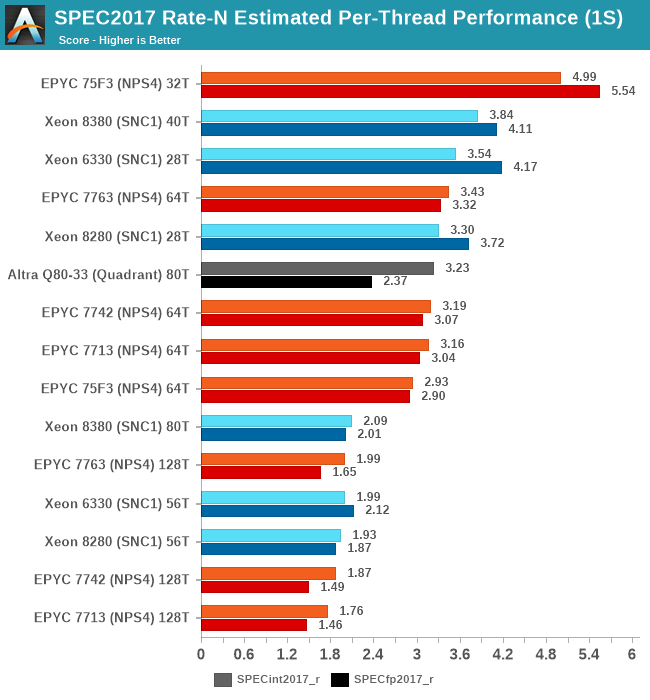Intel 3rd Gen Xeon Scalable (Ice Lake SP) Review: Generationally Big, Competitively Small
by Andrei Frumusanu on April 6, 2021 11:00 AM EST- Posted in
- Servers
- CPUs
- Intel
- Xeon
- Enterprise
- Xeon Scalable
- Ice Lake-SP
SPEC - Per-Core Performance under Load
A metric that is actually more interesting than isolated single-thread performance, is actually per-thread performance in a fully loaded system. This actually is a measurement and benchmark figure that would greatly interest enterprises and customers which are running software or workloads that are possibly licensed on a per-core basis, or simply workloads that require a certain level of per-thread service level agreement in terms of performance.
This has been a strong-point of Intel SKUs for some time now, even when the chips wouldn’t be competitive in terms of total throughput. With the new Ice Lake SPs SKUs now more notably increasing total throughput, it’ll be interesting to see the per-thread breakdown and resulting performance:

Because the total throughput generational performance increase is larger than the core count increase of the parts, this means that per-thread and per-core performance is higher with this generation. The Xeon 8380 is posting +16.3% and +10.4% per-thread performance versus the Xeon 8280 when only using one thread per core.
Interestingly, these figures are less at +8.2 and +7.4% when using both SMT threads per core. Intel has explained such an increase through the better usage of shared microarchitectural structure usage in the new Sunny Cove cores, essentially diminishing the SMT yield by improving 1/T per core performance.
Generally, Intel is extremely competitive in this benchmark metric, and while AMD easily beats them with the frequency-optimised parts, it’s an advantage that should help Intel in the SLA-centric workloads.










169 Comments
View All Comments
Oxford Guy - Wednesday, April 7, 2021 - link
You're arguing apples (latency) and oranges (capability).An Apple II has better latency than an Apple Lisa, even though the latter is vastly more powerful in most respects. The sluggishness of the UI was one of the big problems with that system from a consumer point of view. Many self-described power users equated a snappy interface with capability, so they believed their CLI machines (like the IBM PC) were a lot better.
GeoffreyA - Wednesday, April 7, 2021 - link
"today's software and OSes are absurdly slow, and in many cases desktop applications are slower in user-time than their late 1980s counterparts"Oh yes. One builds a computer nowadays and it's fast for a year. But then applications, being updated, grow sluggish over time. And it starts to feel like one's old computer again. So what exactly did we gain, I sometimes wonder. Take a simple suite like LibreOffice, which was never fast to begin with. I feel version 7 opens even slower than 6. Firefox was quite all right, but as of 85 or 86, when they introduced some new security feature, it seems to open a lot slower, at least on my computer. At any rate, I do appreciate all the free software.
ricebunny - Wednesday, April 7, 2021 - link
Well said.Frank_M - Thursday, April 8, 2021 - link
Intel Fortran is vastly faster then GCC.How did ricebunny get a free compiler?
mode_13h - Thursday, April 8, 2021 - link
> It's strange to tell people who use the Intel compiler that it's not used much in the real world, as though that carries some substantive point.To use the automotive analogy, it's as if a car is being reviewed using 100-octane fuel, even though most people can only get 93 or 91 octane (and many will just use the cheap 87 octane, anyhow).
The point of these reviews isn't to milk the most performance from the product that's theoretically possible, but rather to inform readers about how they're likely to experience it. THAT is why it's relevant that almost nobody uses ICC in practice.
And, in fact, BECAUSE so few people are using ICC, Intel puts a lot of work into GCC and LLVM.
GeoffreyA - Thursday, April 8, 2021 - link
I think that a common compiler like GCC should be used (like Andrei is doing), along with a generic x86-64 -march (in the case of Intel/AMD) and generic -mtune. The idea would be to get the CPUs on as equal a footing as possible, even with code that might not be optimal, and reveal relative rather than absolute performance.Wilco1 - Thursday, April 8, 2021 - link
Using generic (-march=x86-64) means you are building for ancient SSE2... If you want a common baseline then use something like -march=x86-64-v3. You'll then get people claiming that excluding AVX-512 is unfair eventhough there is little difference on most benchmarks except for higher power consumption ( https://www.phoronix.com/scan.php?page=article&... ).GeoffreyA - Saturday, April 10, 2021 - link
I think leaving AVX512 out is a good policy.GeoffreyA - Thursday, April 8, 2021 - link
If I may offer an analogy, I would say: the benchmark is like an exam in school but here we test time to finish the paper (and with the constraint of complete accuracy). Each pupil should be given the identical paper, and that's it.Using optimised binaries for different CPUs is a bit like knowing each child's brain beforehand (one has thicker circuitry in Bodman region 10, etc.) and giving each a paper with peculiar layout and formatting but same questions (in essence). Which system is better, who can say, but I'd go with the first.
Oxford Guy - Wednesday, April 7, 2021 - link
Well, whatever tricks were used made Blender faster with the ICC builds I tested — both on AMD's Piledriver and on several Intel releases (Lynnfield and Haswell).